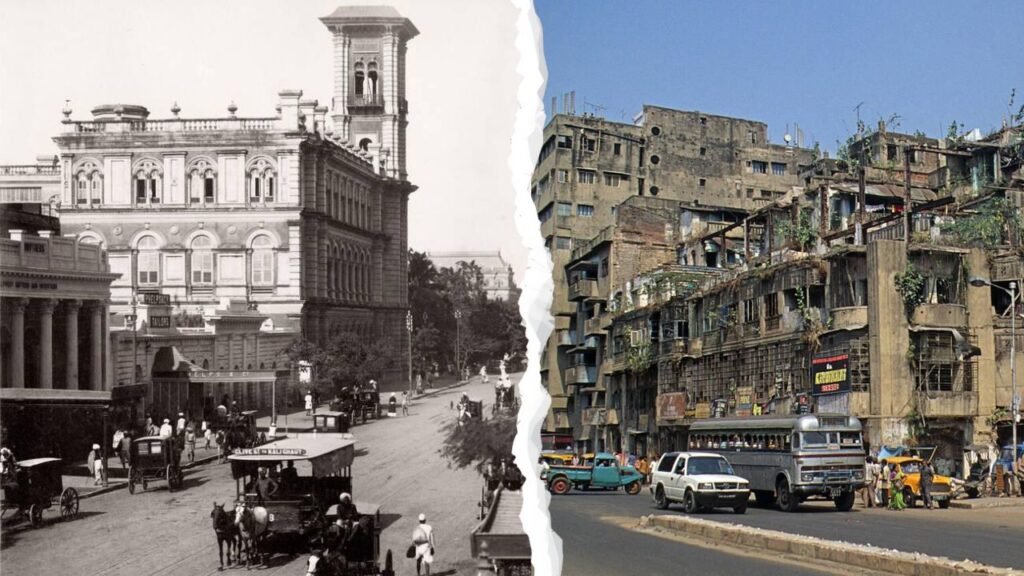Kolkata, once the thriving capital of British India and a powerhouse of commerce, culture, and industry, has experienced a significant decline in its economic and social stature over the past century. The reasons for this loss of glory are complex and multifaceted, involving historical, political, economic, and social factors.

Historical Causes of Decline
- Shift of Capital in 1912: The first major blow to Kolkata’s prominence was the British decision to move the imperial capital from Calcutta (now Kolkata) to Delhi in 1912. This shift gradually distanced Kolkata from the political center of power, reducing its administrative importance and economic influence over the decades that followed.
- The Bengal Famine of 1943: The devastating famine, largely caused by wartime policies of the British government, severely weakened the rural hinterland that supported Kolkata’s economy. This led to long-term socio-economic distress in the region.
- Partition of Bengal in 1947: Partition cut off Kolkata’s jute mills from their raw material supplies in East Bengal (now Bangladesh), crippling a key industry. It also caused massive demographic upheaval, with waves of refugees swelling the city’s slums and straining resources.
Economic and Industrial Decline
- Loss of Industrial Base: Post-independence, Kolkata’s industrial heart—jute mills, engineering works, and metal industries—declined sharply. The Indian government’s policy of “freight price equalization” undermined the region’s comparative advantage in coal, iron, and steel, leading to the collapse of local industries.
- Political Instability and Left-Wing Extremism: The rise of Naxalism and prolonged communist rule (1977-2011) created an environment of political instability, labor unrest, and red tape. This discouraged investment, led to capital flight, and caused many factories to shut down. The city became more known for strikes than industrial productivity.
- Failure to Adapt to Economic Liberalization: While other Indian cities like Mumbai, Bangalore, and Hyderabad embraced liberalization and diversified into IT and services sectors, Kolkata largely remained stuck in traditional industries and Marxist ideologies. This lack of economic diversification and modernization contributed to stagnation.
Social and Infrastructure Challenges
- Urban Decay and Infrastructure Neglect: Kolkata’s infrastructure deteriorated due to insufficient investment and poor governance. Roads, public transport, and essential services suffered, impacting the quality of life and economic competitiveness15.
- Demographic Pressures: Continuous influx of refugees and migrants, especially post-Partition and after the creation of Bangladesh in 1971, strained the city’s resources. This led to overcrowding, expansion of slums, and social tensions.
- Declining Human Development Indicators: Bengal’s ranking in terms of Human Development Index (HDI) fell below the national average, with poor indicators in education, health, and electricity consumption compared to other states. Computer literacy among children is notably lower than in other major cities.
Survey and Statistical Evidence
- Bengal’s GDP per capita ranking fell from 1st in India in 1960 to 23rd in 2019.
- The state’s share in India’s industrial output dropped from 24% in 1947 to 5% by 1998.
- Kolkata’s contribution to corporate tax collections plummeted to barely a tenth of Mumbai’s by 2000-01.
- A CII study excluded Kolkata from the top ten Indian cities for business infrastructure.
- Between 1977 and 2011, Kolkata saw a 60% decline in major industries, with thousands of factories closing.
- Per capita electricity consumption in Bengal is significantly lower than in other states like Gujarat and Punjab.
- Computer literacy among children aged 7 to 14 is less than 50% in Kolkata, compared to over 80% in Bangalore and Chennai.
Conclusion
Kolkata’s loss of glory is the result of a combination of historical disruptions, economic mismanagement, political instability, and social challenges. The city missed key opportunities to modernize and diversify its economy, while political ideologies and labour unrest discouraged investment and industrial growth. Infrastructure decay and demographic pressures further compounded the decline. Despite its rich cultural heritage and intellectual legacy, Kolkata today struggles to reclaim its past status amid rapid growth in other Indian metros.
The decline is not irreversible, but it requires pragmatic governance, investment in infrastructure, economic diversification, and social development to revive Kolkata’s fortunes and restore its position as a major urban centre.
